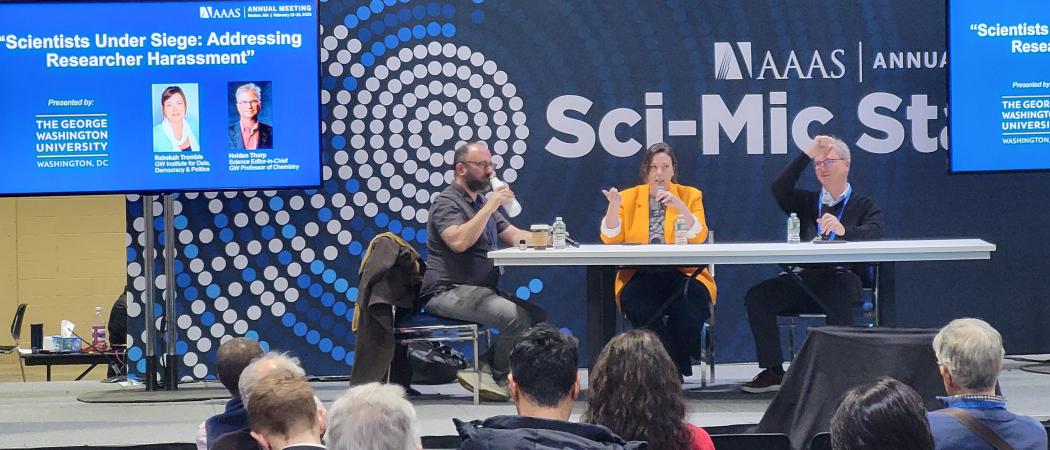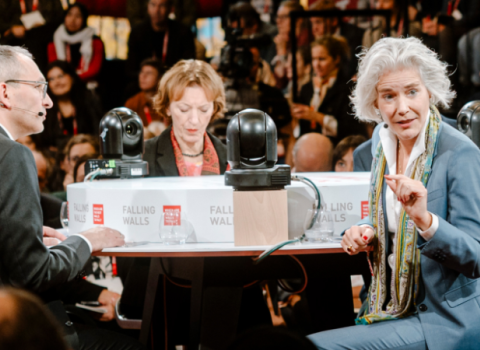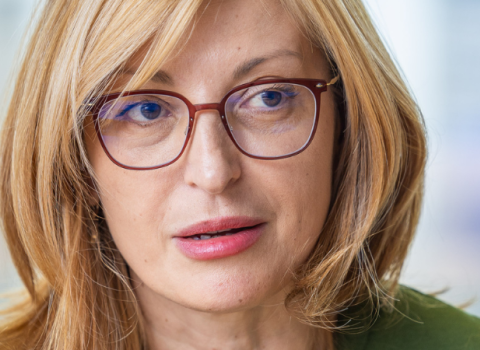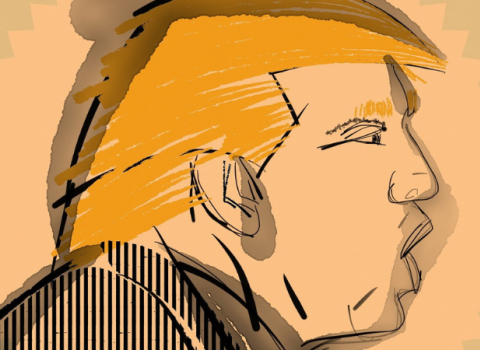At the annual AAAS conference in Boston, scientists and policy makers from around the world debate how to counter layoffs and cuts

"Science under Siege" session at AAAS conference. Photo: Richard L. Hudson
On a cold, snowy weekend in Boston, a few thousand scientists from around the world huddled inside a big conference hall bemoaning Trump layoffs and budget cuts. But outside, a few steps down the street, some old-fashioned resistance was underway.
About 30 protesters were marching outside a Tesla dealership. “Save science, Save lives,” some placards read. “Boycott Tesla,” read another. The group chant: “It ain’t fair, it ain’t funny. President Musk is stealing your money.”
So it goes as the US, and global, science world tries to find its footing in the Trump-Musk hurricane. Many grant payments have been blocked, thousands of science-agency workers abruptly fired, datasets taken down, websites scrubbed, and all this before the administration is a month old. In response, the scientific community is starting to organise, but as yet with no clear plan. That’s true for American scientists, but also for those in Canada, Europe, Asia and elsewhere accustomed to grants and partnerships with the world’s biggest science power.
“A lot of us are in a state of shock. It’s so sudden,” observed Remi Quirion, chief scientific advisor to the Quebec government and president of the International Network for Governmental Scientific Advice, a science policy organisation.
“This is a ‘hair on fire’ moment,” said Rebekah Tromble, a professor at George Washington University. She was speaking at a panel session, titled Science under Siege, at the annual gathering of the biggest US science society, the American Association for the Advancement of Science (AAAS), which took place here in Boston on February 13-15.
Part of the problem is that most American scientists haven’t had much experience with massive political protest since the Vietnam War a generation ago. The most visible protests so far, such as the Tesla demonstration Saturday and a bigger nationwide protest Monday, involve some scientists but have been organised by broader political groups.
In search of a strategy
The AAAS conference was the first opportunity since Trump’s inauguration for a major multi-disciplinary gathering to discuss protest strategy. In the conference corridors, the Union of Concerned Scientists was gathering signatures for a petition to Congress. Conference speakers urged attendees to complain directly, and to download and save scientific datasets before Trump science appointees can block or delete any more. Panellists advised how best to present the case to politicians for saving science: focus on good story-telling, rather than dumping a blizzard of data. One session advised how best to support and comfort colleagues who are laid off or attacked on social media.
But from the leaders of the US science community, the advice was often conflicting or vague on how to deal with the Washington slashers.
During a painfully polite panel discussion, first-term Trump science advisor Kelvin Droegemeier – appearing remotely by video – extolled the “values” of American science even as he argued the need to boost its “efficiency” (aka budget cuts). In the same vein, Marcia McNutt, president of the National Academy of Sciences, said Trump presents an opportunity to take a close look at those science programmes that had grown rapidly – perhaps too rapidly – and reassess what “baseline” science funding really ought to be.
And while Sudip Parikh, chief executive of the AAAS, had strongly decried budget cuts in other conference sessions, with Droegemeier on the video screen he took a more pragmatic tack. He said he was “100% focused” on the next big budget bill Congress is working on, to be completed by March 14. For that, he suggested, scientists will need at least a few Republican friends, and should pick their shots carefully.
What is a non-American to do?
All of this was confusing to the hundreds of researchers and science policy makers attending from abroad. Since World War II, the US has been the acknowledged scientific leader for many domains, including vaccines, computers, the Internet and, today, artificial intelligence. Over the decades, millions of foreign scientists have trained at American universities, many here in Boston at Harvard, MIT, Boston University, Northeastern University, Tufts and other famous institutions. Many stayed, and have now made their lives and research careers here. So what happens next for them?
One possibility: they return home. That prospect already has science officials around the world doing some fast thinking. Many US partner countries already have some kind of repatriation awards for returning scientists, and discussions have begun about boosting funding for that, a once-in-a-century opportunity to strengthen their own science communities and reverse brain drain. Another possibility: expanding programmes to attract American scientists to work abroad. Not surprisingly, diplomats at the conference were, well, diplomatic about making any on-the-record comments on this topic.
Then there’s the more immediate worry about funding cuts to international research groups. Some European officials, for instance, are closely monitoring existing research consortia for evidence of cuts affecting them. But given how tight EU and member state budgets already are, there isn’t any consensus yet on whether they can take up the funding slack. One possibility: forging closer relations with science administrators in those ‘blue’ American states with sizeable science programmes of their own, such as New York, Massachusetts and California.
Under the circumstances, the conference’s exhibition hall – with stalls booked long before Trump’s inauguration – was transformed into a noisy sales floor. The Technical University of Dresden, Canada Science and Innovation, the Japan Society for the Promotion of Science, the Science Diplomacy Capital for Africa and others hawked their scientific wares and opportunities alongside American institutions, hoping to attract American students, scientists or partners, though not, for the moment, US funding.
And near the front of the hall, the Chinese Academy of Sciences organised a series of lectures. The aim, one official explained: to advertise its programme offering access to a portfolio of 38 different research infrastructures – synchrotron, tokamak, research vessel, neutron source and others – all free of charge to visiting scientists. The academy has participated in AAAS meetings since at least 2009.
Still, most scientists are by nature an optimistic breed. Monica Bertagnolli, the director of the National Institutes of Health just sacked by Trump, urged some historical perspective. The agency is the world’s largest government funder of medical research, and Congressional support for it has been bipartisan throughout its history.
“The dust is going to settle,” she said. “Things are in a state of disruption right now. But I have an absolute belief that the value of science will not go away.”





 A unique international forum for public research organisations and companies to connect their external engagement with strategic interests around their R&D system.
A unique international forum for public research organisations and companies to connect their external engagement with strategic interests around their R&D system.